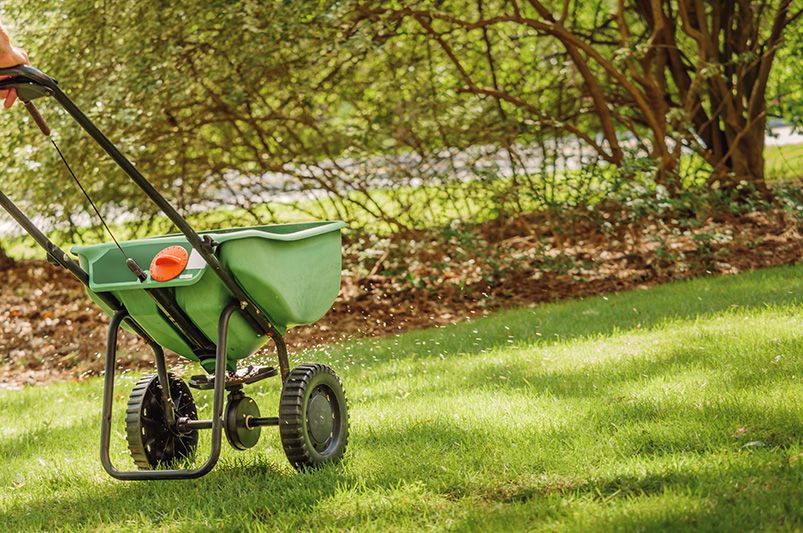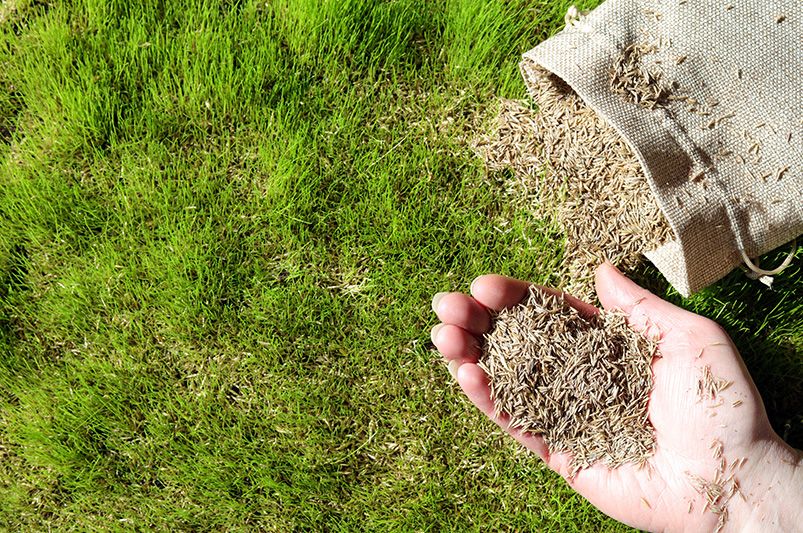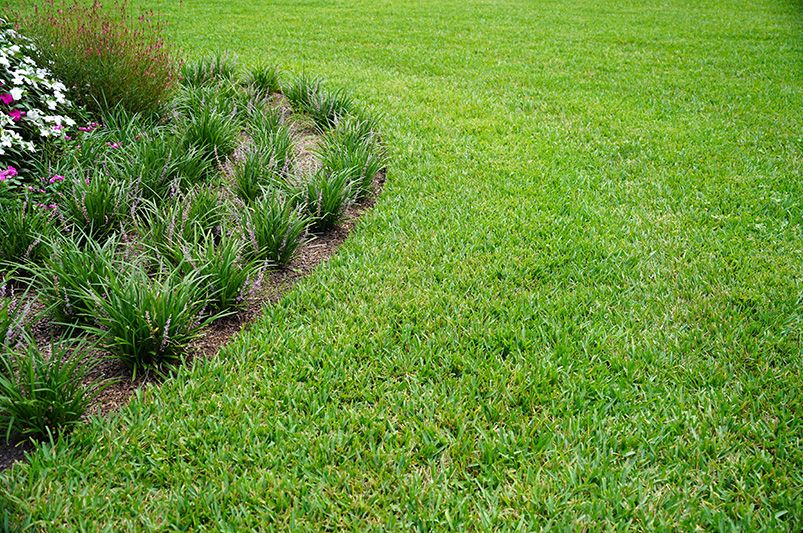
The Benefits of Overseeding Your Lawn
Published: 09/10/2024 | Updated: 09/10/2024
The Benefits of Overseeding Your Lawn
Every homeowner dreams of having a lush, green lawn that turns heads and enhances the beauty of their outdoor space. However, over time, even the healthiest lawns can start to thin, develop bare patches, or struggle with weeds and pests. That’s where overseeding comes in—a simple yet effective technique to breathe new life into your lawn by planting new grass seed directly into existing turf.


Overseeding can significantly improve the density and overall health of your lawn, making it more resilient to environmental stressors, from harsh weather to heavy foot traffic. Whether you’re looking to thicken your lawn, prevent weeds, or enhance its color and vibrancy, overseeding is the perfect solution.
If you’re ready to transform your lawn, ShrubHub’s weekly blog is packed with expert advice, tips, and tricks to help you take your outdoor space to the next level. Let’s dive into the benefits of overseeding and how it can give you that lush, healthy lawn you've always wanted.
What Is Overseeding?
Overseeding is the process of spreading grass seed directly onto an existing lawn without tearing up the soil or removing the turf. It’s a vital practice for maintaining a healthy, vibrant lawn, especially if your yard is beginning to show signs of thinning or patchy growth. By introducing fresh grass seed, you’re essentially revitalizing your lawn, allowing new, more resilient grass to grow alongside the older turf.
Lawn issues like bare spots, thinning, or a lack of uniform color are often caused by aging grass, poor soil quality, or environmental stressors. Overseeding addresses these problems by promoting new growth that strengthens and densifies your lawn. It’s particularly useful for older lawns where the grass may have deteriorated over time, losing its ability to thrive under seasonal changes or heavy usage.
Beyond aesthetic improvements, overseeding also helps prevent issues like weed infestation and soil erosion. By encouraging a thicker lawn, you’re effectively crowding out weeds that compete for space and nutrients. Additionally, overseeding enhances your lawn’s ability to absorb nutrients and water, making it more resilient in the long run.
Overseeding is not just about fixing problems; it’s also a proactive approach to maintaining a lawn that stays healthy year-round. Whether you're facing common lawn challenges or simply want to give your outdoor space a fresh boost, overseeding is an essential part of keeping your yard in top shape.

Key Benefits of Overseeding
Overseeding is more than just a lawn care fix—it’s an investment in the long-term health and beauty of your lawn. By regularly overseeding, you can enjoy several significant benefits that will keep your yard looking lush and vibrant throughout the seasons. Here’s a closer look at the key advantages:
A. Thicker, Healthier Turf
One of the most immediate and noticeable benefits of overseeding is the creation of a thicker, fuller lawn. Overseeding helps fill in bare or thinning areas, making your lawn more visually appealing and durable. A dense turf not only looks better, but it also strengthens your lawn’s ability to resist damage from foot traffic, pets, and environmental factors. A thick lawn also provides a soft, even surface, making it a more comfortable and enjoyable outdoor space for family gatherings, playtime, and relaxation.
B. Weed and Pest Prevention
A thick, healthy lawn is your best defense against weeds and pests. When grass is sparse, weeds can easily invade and spread, competing for nutrients, water, and sunlight. Overseeding helps crowd out these unwanted plants by filling in the gaps, leaving less room for weeds to take hold. Similarly, a dense lawn creates an environment that is less inviting to pests, which thrive in weak or patchy turf. By overseeding, you’re fortifying your lawn against these common invaders.
C. Better Tolerance for Stress and Weather Conditions
Whether it’s a scorching summer, a chilly winter, or frequent foot traffic, lawns face a variety of stressors that can lead to thinning and discoloration. Overseeding introduces new, hardy grass varieties that are better suited to handle changing weather conditions and stress. By adding a mix of grass types, you can improve your lawn’s resilience, ensuring it stays green and strong even under tough conditions. Overseeding in the fall is especially beneficial, as it prepares your lawn to endure the winter and emerge healthier in the spring.

How to Overseed Your Lawn Properly
Overseeding might seem straightforward, but to achieve the best results, there are a few crucial steps you need to follow. Proper preparation and execution will ensure that your new grass grows strong, fills in bare spots, and blends seamlessly with your existing turf. Here’s how to overseed your lawn the right way:
Preparing Your Lawn for Overseeding
Before you begin, it’s essential to prepare your lawn to ensure the new grass seed has the best chance of establishing itself. Start by mowing your lawn shorter than usual, which will allow the seeds to penetrate the soil better. Once mowed, rake the lawn to remove any thatch or debris, creating a clean surface for the seeds to make direct contact with the soil. For lawns with compacted soil, aeration is recommended to allow for better airflow and water absorption.
Choosing the Right Grass Seed
The type of grass seed you choose for overseeding is critical to achieving a successful result. Different grass species thrive in different climates, so it’s essential to choose a seed blend that suits your region and soil type. Cool-season grasses, such as Kentucky bluegrass or fescue, are ideal for cooler climates, while warm-season grasses like Bermuda or zoysia perform better in warmer regions. Be sure to select a high-quality seed mix that complements your existing lawn for a cohesive appearance.
Spreading the Seed
Once your lawn is prepared and the right seed is selected, it’s time to spread the grass seed evenly across the yard. You can use a broadcast spreader or hand spreader for this task, making sure to apply the seed in two directions to ensure even coverage. Pay special attention to bare patches or thinning areas, applying extra seed to these spots. After spreading the seed, lightly rake the lawn to ensure good seed-to-soil contact, which is essential for germination.
Watering and Post-Seeding Care
Water is crucial for helping your new seeds germinate and grow. After overseeding, water the lawn gently but thoroughly to moisten the soil without creating puddles. For the first few weeks, it’s important to keep the soil consistently damp to encourage the new grass to take root. Water lightly and frequently until the seeds sprout, then gradually transition to deeper, less frequent watering as the grass matures. Avoid heavy foot traffic on your lawn during this period to protect the new growth.
By following these steps, your lawn will be well on its way to becoming a thick, lush carpet of green. Overseeding is a long-term investment in your lawn’s health, ensuring it stays vibrant and resilient year after year.

Maintaining Your Lawn After Overseeding
Once you've overseeded your lawn, the journey to a lush, green landscape doesn't stop there. Proper post-overseeding care is crucial to ensure that the new grass takes root and thrives. By following best practices for watering, fertilizing, and mowing, you’ll give your lawn the best chance to grow thick and strong. Here’s how to maintain your lawn after overseeding:
Watering Your Lawn
Watering is the most critical factor in helping new grass seeds germinate and establish roots. After overseeding, it’s important to keep the soil consistently moist. In the first two weeks, water your lawn lightly but frequently, ensuring the top inch of soil remains damp without becoming waterlogged. As the new grass begins to grow, you can gradually reduce the frequency of watering while increasing the duration. This encourages deeper root development, making your lawn more drought-resistant over time.
Fertilizing for Growth
Providing your lawn with the right nutrients is essential after overseeding. About two to three weeks after the new grass has germinated, apply a balanced fertilizer to promote healthy growth. Look for a slow-release fertilizer that contains nitrogen, phosphorus, and potassium—key nutrients that encourage both root development and strong blade growth. Avoid over-fertilizing, as this can burn young grass or encourage weed growth. Regular fertilization, in combination with good watering habits, will help your lawn reach its full potential.
Mowing the New Grass
Mowing is another important aspect of post-overseeding care. Resist the urge to mow the new grass too soon—wait until it reaches a height of about 3 to 3.5 inches before giving it the first cut. Set your mower blades to the highest setting to avoid cutting the grass too short, which can stress the young plants. After the initial mowing, continue to mow regularly, but never remove more than one-third of the grass blade length at any time. This will promote healthy growth and prevent the grass from becoming too weak.
The Importance of Ongoing Maintenance
To ensure the long-term success of overseeding, ongoing lawn care is a must. Regular watering, fertilization, and mowing will keep your lawn looking its best, but periodic overseeding may still be necessary to maintain a thick, green turf. It's also essential to monitor your lawn for any signs of pests or weeds and address issues as soon as they arise to prevent damage.
If you’re looking for expert help with lawn maintenance, ShrubHub offers customized lawn care plans tailored to your yard's unique needs. From regular maintenance to more advanced services like soil aeration and weed control, our local contractors are ready to help you keep your lawn in pristine condition all year long. Whether you need guidance on post-overseeding care or a complete lawn overhaul, ShrubHub is here to assist you every step of the way.
Conclusion
Overseeding is one of the best ways to rejuvenate your lawn, ensuring it remains thick, healthy, and vibrant throughout the year. By incorporating overseeding into your regular lawn care routine, you’re investing in a lush, resilient landscape that can withstand seasonal changes, foot traffic, and environmental stressors. From thicker grass to improved resistance against weeds and pests, the benefits of overseeding are clear.
For homeowners looking to achieve professional-level results, ongoing maintenance is just as crucial as the overseeding process itself. Whether it’s proper watering, fertilizing, or mowing, these small steps can make a big difference in the success of your lawn.
Ready to take your lawn to the next level? ShrubHub offers comprehensive landscape design services to help you oversee the entire process, from selecting the right grass seed to installing custom irrigation systems for optimal growth. Plus, our reliable local contractors can provide ongoing lawn care and maintenance to ensure your outdoor space stays in top shape year-round.
Get started today by visiting ShrubHub and let’s transform your yard into the lush, green paradise you’ve always dreamed of!


